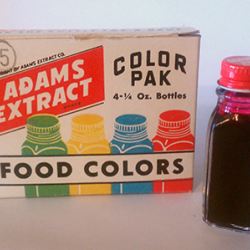Previously I discussed the inaccuracies and misdirection found in "Seeing Red", a marketing and advocacy screed labeled as a 'white paper' by the Center for Science in the Public Interest (CSPI). In and amongst the plethora of hand-picked papers simplified for an audience of concerned, but not expert, citizens I found two quotes, from their experts testifying before the FDA review committee, that I think, summarize their goal, at least scientifically.
“As I’ve mentioned, causality is a distant aspiration, but certainly these data don’t give us any confidence that we can say there’s nothing to worry about here, this problem is taken care of, this shouldn’t be looked at.”
“Studies suggest a statistically significant but clinically limited role for dietary treatments (both supplements and exclusions)—far less than envisaged by some of the promoters of the diet-behavior narrative but greater than expected by their sceptics.”
"Seeing Red" in its call to action claims to want “To protect children’s health, FDA should revoke approvals for all food dyes.” And to that end asks this question for which its lawyers only have one answer; “…does the use of dyes satisfy the legal standard for the safety of colorings, when the evidence on behavioral impacts in sensitive children is considered?”
Of course it does, from a scientific and health perspective. But that is why they are in the lawsuit business. You don't need science if you have an epidemiologist replacing evidence with statistics. CSPI argues that the EPA took action to reduce pollution based on children with asthma which affects about 8% of children. But air pollution is far harder to avoid than foods, and 8% is a larger number than 1% that CSPI’s calculation claims are impacted by food coloring. Asthma and air pollution have a defined bological mechanism [1], their claims about food dyes are anecdotes equivalent to people who claim radio waves are giving them headaches. Even if their claims are accurate, the question before us is whether a possible (or should you wish to say probable) risk to less than 1% of the population merits the banning of CCA for everyone? Are there other, more precise and effective actions that a concerned citizen can support?
Warning labels are their preferred alternative, but CSPI suggests them only as a temporizing measure. For the concerned parent, information about food coloring is already present on the required listing of ingredients. Is anyone likely to fall for this campaign not already reading the label and knowing that the FDA has identified the food products that “contributed the most” to exposure to CCAs and they are “Breakfast Cereal, Juice Drinks, Soft Drinks, and Frozen Dairy Desserts/Sherbet (also referred to as Ice Cream, Frozen Yogurt, Sherbet (including Bars, Sticks, Sandwiches).” [2]
Concerned parents can just buy alternatives, or at least not bring these foods home and inform their friends not to give their children those type of treats. Why does CSPI insist on a ban for al people about something that, even if their belief in anecdotes are accurate is just 0.15%?
CSPI invokes ADHD and concedes that medication remains the primary management tool. They even are forced to concede (the FDA frowns on making claims that are outright falsehoods, as CSPI lawyers well know) that dietary interventions are simply adjunctive measures and just something to try when medications are not effective. Certainly, this information can and should be provided to parents by the prescribing physician. But parsing out food coloring as part of diet?
Scientific evidence in the service of policy determination is necessary but sometimes we just don't know. Not knowing everything is not a reason not to act but it should not also be a wedge that litigation groups use to raise money and scare the public. "Seeing Red" is a tool for CSPI, it is effective advocacy and a call to action. But the misdirection underlying their advocacy undercuts their credibility. If they are lying, or even simply wrong, about obvious facts, who is to say they were truthful about others?
NOTES:
[1] Let us, for the sake of argument, consider the 8% figure CSPI is pushing, that is about 500,000 children. It is hard to get a precision in the number of children in the U.S. in that age group, but census figures would put it roughly at three to four million. So the group at risk is 1%. If we are to consider the entire U.S. population, the at-risk population nearly ten fold less, 0.15%.
[2] Here is the list noted in Seeing Red: Pillsbury Confetti Funfetti Chocolate Fudge Frosting, Red, White and Blue Popsicle, Twizzlers, Skittles, Hawaiian Punch, Fruity Pebbles, M&Ms, Sunkist Orange Soda, Ken’s Light Raspberry Walnut Vinagrette, Sugar Free Chocolate Wafers, Utz Baked Cheese Curls, Fruit by the Foot and Open Pit Barbecue Sauce. There is a whole lot of candy on this list; and how many children are putting light raspberry walnut vinaigrette on their vegetables?

